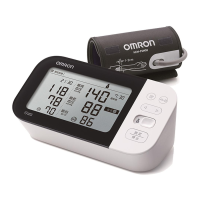EN66
12. Useful Information
What is Blood Pressure?
Blood pressure is a measure of the force of blood flowing against the
walls of the arteries. Arterial blood pressure is constantly changing
during the course of the heart’s cycle.
The highest pressure in the cycle is called the Systolic Blood
Pressure; the lowest is the Diastolic Blood Pressure. Both pressures,
the Systolic and Diastolic, are necessary to enable a physician to
evaluate the status of a patient’s blood pressure.
What is Arrhythmia?
Arrhythmia is a condition where the heartbeat rhythm is abnormal due
to flaws in the bio-electrical system that drives the heartbeat. Typical
symptoms are skipped heartbeats, premature contraction, an
abnormally rapid (tachycardia) or slow (bradycardia) pulse.
What is Afib?
Atrial fibrillation (also called Afib or AF) is a quivering or irregular
heartbeat (arrhythmia) that can lead to blood clots, stroke, heart
failure and other heart-related complications. During atrial fibrillation,
the heart’s two upper chambers (the atria) beat chaotically and
irregularly — out of coordination with the two lower chambers (the
ventricles) of the heart. Episodes of atrial fibrillation can come and go,
or you may develop atrial fibrillation that doesn’t go away and may
require treatment.
Afib indicator function detects the possibility of Afib with an accuracy
of 94.2 % (with sensitivity of 95.5 % and specificity of 93.8 %) as
demonstrated in the study* with Single-lead ECG as reference
measurement.
* M. Ishizawa, T. Noma, T. Minamino et al. Multiple measurements
with automated blood pressure monitor can detect atrial fibrillation
with high sensitivity and specificity in general cardiac patients, ESC
Congress 2018
2895901-4A_HEM-7361T-ALRU_IM.fm Page 66 Wednesday, October 26, 2022 10:46 AM

